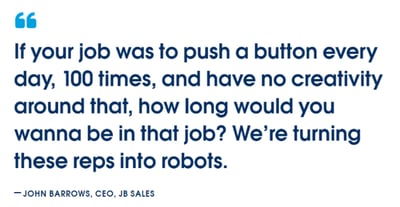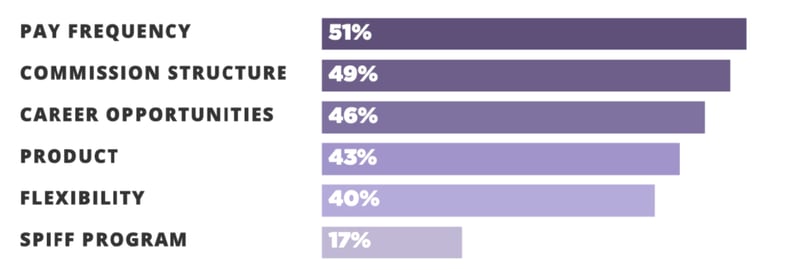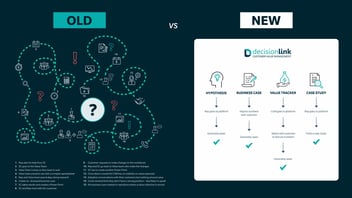The Great Resignation and the Sales Team

No industry is immune to The Great Resignation, especially in the go-to-market realm. Salespeople may be particularly susceptible to the phenomenon for a variety of reasons including but not limited to working 100% remotely, timing of the commission payments, pay levels due to increased uncertainty, and a lone-wolf mentality that can quickly lead to burnout and a lack of attachment to their teams.
According to HubSpot, the average sales turnover rate is 35%, compared to an average turnover rate of 13% for all industries. That’s nearly triple the average turnover rate [1]. That number does not factor in the impact of COVID-19 and the latest two years on unpredictability. It is clear that your sales reps are becoming the targets of the most admired companies and big reputable brands [2]. These companies offer better opportunities, more stability, and potentially a better working environment.
Let us look at some of the current pressures on the sales roles that may trigger employees to search for better pastures.
- Incremental automation making functions and roles obsolete: It is undeniable that many of the sales roles have been automated and turned into “push-button” roles. The emergence of automated systems has made some roles clerical in nature taking away most of the decision-making power through machine learning or AI logic. Roles in quoting, sales support, and lead generation might become less interesting as become more and more automated.

- Legacy systems are becoming more and more obsolete: At the same time, people working with legacy systems might also be considered as less attractive and not mainstream. It might be less rewarding to work on old sales system that are not upgraded or maintained and are seen as low value in the organization.
- Lack of automation in some areas creates stress and impacts productivity: Like pressures 1 and 2, some companies are still working on sales systems that are very manual in nature, that create workarounds and manual interventions, and are not the most user friendly. This is an area of concerns for sales roles that are constantly under stress and pressure to maintain productivity gains while managing manual processes. The potential for burnout is high in functions of customer service, customer support, and inside sales.
- Lack of new ways of working in sales lead to a search of more progressive companies: Some companies are stuck in their ways and continue to use traditional and antiquated commercial processes. The lack of innovation in process, methods, and organizational design makes the job repetitive and boring. Sales reps often read about best practices deployed in other more progressive companies and wonder what it would be like to have access to them. Sales innovations include customer success roles, customer value management programs like ValueCloud®, and formal value-based selling methodologies.
- Remote work leads to burn out and a search to hybrid work environment: The sales profession is organized and focused on meeting people, listening to people, understanding people, building trust with people, and sharing success with people. When sellers were working from home and spent almost two years separated from people to survive a pandemic, leaders should expect a change in the dynamic that could affect morale and motivation. With a turnover rate already high pre-pandemic, sales leaders should expect even higher rates of resignation. Right now, and after two years, sellers are emerging from lockdown and deciding to leave their jobs.
There are plenty of surveys out there. Anaplan conducted a survey with 400 sales people and listed the top five reasons for quitting: Based on the survey results, here are the five top reasons your sales people are leaving [3]:
- Confidence in offering portfolio
- Quota assignments
- Confidence in company stability
- Confidence in sales leadership/management
- Better opportunity
Everee conducted a survey with 700 salespeople asking them to select all the factors that influence their decision to do sales for one company over another [4]. Here’s how they responded in the visual below:

Would you like to see ValueCloud in action? Book a no-obligation demo now.
The sales function is still at risk for additional resignation in rapid numbers if sales leaders and their companies do not take specific actions. Here are some of the things leaders can do to keep your sales team stable:
- Be creative in the way you pay your sales team.
- Salespeople want to be paid differently than most of them currently are. The same Everee study found 56% of respondents don’t get their commissions for at least two weeks. Four out of 10 get their commission monthly or quarterly. Unsurprisingly, 64% of salespeople said they would prefer to get commissions within a week. The longer time it takes to receive earned commissions increases the risk and uncertainty involved in a sales job [5].
- Introduce SPIF based on current unpredictability. Of course, compensation matters. Benchmark data from SiriusDecisions shows 89% of sellers leave for higher pay [6]. Special performance incentive funds, or SPIFs, are also commonly used incentives. More than 50% of best-in-class companies see increased profits using SPIFs, Aberdeen Group research shows.
- It might be a good idea to give your sales team a strategic project in which they need to collaborate. This can be anything from managing a strategic deal to launching a new market, or to introduce a new way of working in which commission is split between multiple participants to team-wide strategy development sessions.
- Create a team environment. Making your team work as a team will help them feel like they’re part of something bigger than themselves. A togetherness mentality can improve motivation and the sense of belonging, but more importantly, it might help each individual team member feel connected to your business and help them resist the temptation to take their talents elsewhere. A sense of belonging is undeniably critical for long-term employee satisfaction. In fact, there's a 91% correlation between employees who say they belong and those who stay engaged at work [7] and a 50% drop in attrition among employees who report a sense of belonging [8].
- Propose an upgrade to the sales roles with better tools, more time to sell, and great support from technology. Increase job satisfaction and willingness to explore safely by introducing new tools and platform to make work easier. Those include a commercial excellence platform or a customer value management platform. Vendavo reports that the right technology can provide more than just the chance to digitize your sales processes but supplies ways to transform them so your sales organization can be more confident and informed about the opportunities around them [9].
- Re-engage with sales teams and reduce the pressure for a period. Spend more one-on-time with your sellers and key account executives. The topic for these meetings must be development, not production. Focus on each person individually. Get to know them as people instead of just sellers. Listen to their ideas. Understand their goals. Know what is important for them to achieve in their sales job. Be generous with praise. Reward simple advances. One of the most common complaints I hear from sellers is this: “Nobody ever thanks me.” “Nobody ever stops to point out what I’ve done.” “Nobody is ever grateful.” [10] Take your coaching style and frequency to the next level [11].
- Reduce the ongoing pressure and take a break. After two years in the pandemic, when people are feeling disconnected and burned out and unsure of their future, it is common sense to avoid too much pressure and focus on small wins and little goals. Forget the pressure of the 20% improvement — try focusing on a 1% gain.
- Invest in the development of your sales organization. Spend money in the short term to avoid a serious issue in the long run. The cost of turnover in sales is very high. Josh Bersin of Deloitte says the cost of losing an employee can range from tens of thousands of dollars to 1.5-2X the employee's annual salary [12]. If you lose an employee who was making $70,000, you can expect to lose upwards of $140,000. Calculate how long it takes to recruit, on board, and develop a new sales rep. We are talking anywhere between 3 to 9 months before the rep is at cruising altitude. The cost is a certainty. The lost sales opportunity is even bigger. Think in terms of late-stage deals in the pipeline that suffer disruption, customer relationships that need get reset back to stage one, time where the territory is being underserved and opportunities lie dormant, or worse, passed to competitors. The average onboarding time to 100% quota attainment is 9-12 months [13].
CROs should pay close attention to the increased turnover in their go-to-market teams and particularly to sales and account executives. It is a very sensitive and strategic time right now after two years of semi lockdown. CROs and HR teams should be joined at the hip to prevent a mass exodus that will certainly create disruption and impact growth. This is number one priority!
Bio

Dr. Stephan Liozu (www.stephanliozu.com) is the Founder of Value Innoruption Advisors (www.valueinnoruption.com), a consulting boutique specializing in industrial pricing, digital business, and value models, and value-based pricing. Stephan has 30 years of experience in the industrial and manufacturing sectors with companies like Owens Corning, Saint-Gobain, Freudenberg, and Thales. He holds a Ph.D. In Management from Case Western Reserve University, and has authored several books, including his latest book, The Industrial Subscription Economy (2022). Stephan is a strategic advisor to DecisionLink and Monetize360, as well as a senior advisor at BCG.
[1] Why Millions of U.S. Employees are Quitting Their Jobs and How Companies Can Navigate (hubspot.com)
[2] How B2B Brands Are Becoming Talent Magnets | The Drum
[3] Five reasons your best sales people are leaving | Anaplang
[4] (The 2021 sales pay & performance survey report | Everee
[5] How to Keep Your Sales Team Intact During the Great Resignation (msn.com)
[6] (It’s Turnover Time for Sales (forrester.com)
[7] Workplace Belonging: Increase Engagement in 2022 - Qualtrics
[8] The Value of Belonging at Work (hbr.org)
[9] Protecting B2B Sales Teams from the Great Resignation - Vendavo
[10] The Great Resignation In Sales Is Real: Here’s What Leaders Can Do To Stem It (forbes.com)
[11] 6 Ways Sales Leaders Can Counter The Great Resignation | Salesforce
[12] Employee Retention Now a Big Issue: Why the Tide has Turned | LinkedIn
[13] The Great Resignation & What Sales Leadership Can Do About It (netcommissions.com)

 ValueCloud
ValueCloud
.png?width=118&height=76&name=Rectangle%20(3).png) ValueCloud Ignite
ValueCloud Ignite
.png?width=92&height=92&name=Rectangle%20(4).png) Free Assessment
Free Assessment
.png?width=100&height=100&name=Rectangle%20(5).png) Watch a Demo
Watch a Demo
.png?width=82&height=96&name=Rectangle%20(6).png) Value Calculator
Value Calculator

.png?width=62&height=51&name=Group%2010%20(1).png) Marketing
Marketing
 Sales
Sales
 Customer Success
Customer Success
 Engage Prospects
Engage Prospects
 Win Deals Faster
Win Deals Faster
 Retain Customers
Retain Customers
.png?width=62&height=62&name=Rectangle%20(8).png) Adopt and Scale
Adopt and Scale
.png?width=54&height=54&name=Rectangle%20(9).png) Cybersecurity
Cybersecurity
 Healthcare
Healthcare
.png?width=54&height=54&name=Rectangle%20(10).png) IT & Software
IT & Software




